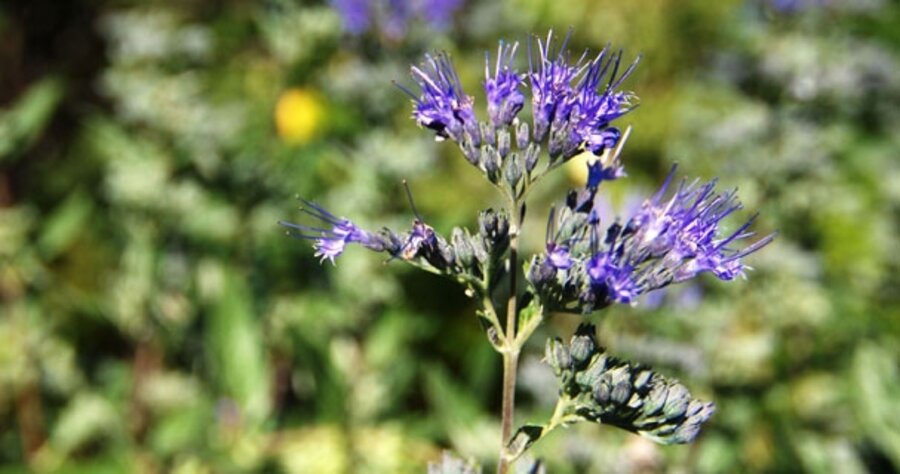Amid fall hues, a splash of blue
Loading...
Plant publicists and catalog copywriters tend to play fast and loose with the adjective “blue,” often pinning it to unsuspecting flowers that are actually more purple than blue.
But, depending on the soil, caryopteris, a small shrub, bears vibrant flowers that come closer to “true blue.”
Even better, those blooms appear at the end of summer and the beginning of fall when most other flowers are fading away.
The best known caryopteris is a hybrid, Caryopteris x clandonensis, which has been around American gardens for years and is often known by evocative nicknames including blue spirea, blue mist shrub, and bluebeard.
It is a plant of many virtues. Tomasz Anisko, curator of plants at Longwood Gardens in Kennett Square, Pa., characterizes the blue color of the fringed flower clusters as “outstanding.”
The shrub is also compact, easy to grow, and drought tolerant, with gray-green, aromatic leaves that have a fragrance somewhat reminiscent of lavender and rosemary. Butterflies and other pollinating insects find the blossoms irresistible.
Although caryopteris has been commercially available for some time, it has never achieved bestseller status.
In 1947, the Wayside Gardens catalog was restrained in its praise, describing caryopteris as “a truly worthwhile plant for the flower border as well as for in front of the shrubbery border.”
Ten years later, in 1957, curators at the Villa Taranta botanical garden in Italy’s Piedmont region sent a promising blue mist shrub to colleagues at Longwood Gardens, where it thrived but did not inspire a groundswell of popularity.
The situation did not change until 1987 when a new variety, selected and propagated at Longwood, was introduced by Wayside under the name ‘Longwood Blue.’ And for more than 10 years, an allée of two-foot-tall ‘Longwood Blue’ has delighted visitors to the Pennsylvania institution.
Now, says Dr. Anisko, caryopteris may be ready for an even greater surge in popularity, partly because of breeding and plant selection work done in Europe.
New varieties offer a host of desirable attributes including greater flower color intensity, golden-green or variegated leaves, and more compact growth habits.
Britain’s Royal Horticultural Society conducted trials of Caryopteris x clandonensis varieties in 2002 and 2007, bestowing its Award of Garden Merit on seven varieties.
Anisko also thinks that one of Caryopteris x clandonensis’s parent species, Caryopteris incana, will soon prove popular with the public, primarily because its prostrate or creeping growth habit makes it suitable for containers and hanging baskets.
‘Blue Billows,’ a Longwood-bred variety descended from a Korean plant discovered in 1966, has languished in near obscurity for years. Now, according to Anisko, the Burpee Seed Co. may be interested in growing the plant for commercial distribution.
With new and improved varieties of caryopteris on the market, commercial landscapers are beginning to catch on to the appeal of the blue mist shrub.
Home gardeners won’t be far behind. It’s probably only a matter of time before this sun-loving plant brings a lot more “true blue” to America’s backyards, porches, and containers.





